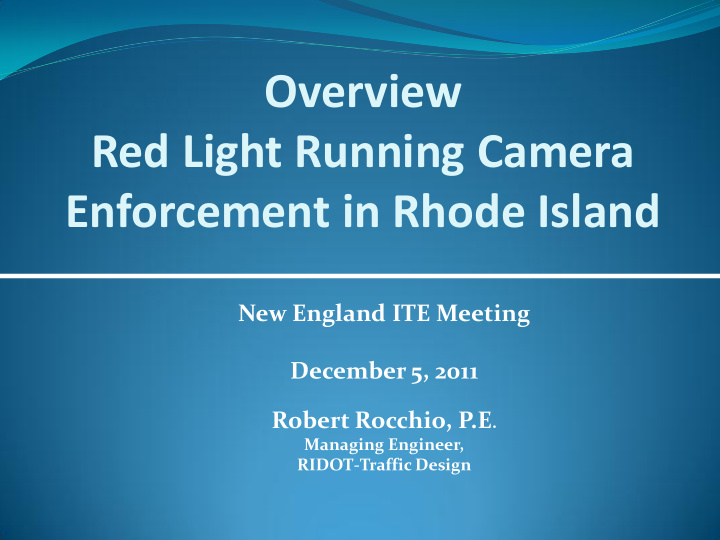



Overview Red Light Running Camera Enforcement in Rhode Island New England ITE Meeting December 5, 2011 Robert Rocchio, P.E . Managing Engineer, RIDOT-Traffic Design
Background Initiated by City of Providence in 2003 . District Court cautioned that a State Statute was needed . Providence Congressional delegation introduced the “Rhode Island Automated Traffic Violation Monitoring System (ATVMS) Act of 2005”
Background (Cont’d) Support by Highway and Safety Officials, Municipalities, and Insurance Institute (IIHS). Safety Benefits … Number and severity of crashes reduced Revenue Source Received Opposition from ACLU & NMA Ability to challenge ticket harder Privacy concerns Potential for abuse by inducing violations Could discourage engineering solutions
ATVMS LAW - Highlights Rhode Island General Laws Section 31-41.2-1 et seq. Broad policy “ utilize the best available technology for the monitoring and prosecution of civil traffic violations, including automated traffic violation detection systems.” R.I. Gen. Laws § 31-41.2-2. Limited authorization red light running enforcement cameras only sunset provision effective July 19, 2008 (subsequently repealed)
ATVMS LAW – Highlights (cont’d) • Requires approval from DOT Director prior to installation. Requires DOT Director to promulgate rules and regulations. Prohibits compensation to vendors based upon the revenue generated by such systems.
ATVMS LAW – Highlights (cont’d) Further requirements: Photo enforcement signs Annual reports Citations to be issued within 14 days Nature of violations: Civil, not criminal Privacy Protections Photographs are not “public records” and must eventually be destroyed
ATVMS – Goals of Program Increase Safety Revenue Generation Not a Concern Maintain Public Support
ATVMS – Rules and Regulations Questions to be answered: Single/multiple vendors selected/pre-qualified by DOT through RFP Process? Would Towns choose own vendors? Who would pick locations? Who would administer the program? Who pays to install and maintain Systems? Etc.
Approval Process Vendor Technical specs submitted by city/town. • No specific technology criteria. • Once approved then placed on pre-approved list. Intersection • Engineering study report required. • Intersections Selected by City or Town. • Permit also Required at State Owned intersections . • Review of Annual reports (violations, crashes, etc.)
Performance Criteria ATVMS Minimum Requirements : Recorded image of vehicle and rear plate prior to entering intersection. Recorded image of vehicle and rear plate in intersection during a red indication. Time, date, location, and duration of red at time of entry. Min. delay or “grace” time of .2 seconds. Yellow interval verification.
Regulations – Engineering Study Intersection meets traffic signal warrant criteria. 1. Yellow times in conformance with ITE Handbook . 2. Yellow times adjusted for 85th percentile. 3. All red intervals set to a minimum of 1 second. 4. Signal faces un-obstructed and sight distance o.k . 5. Signal face horizontal & vertical locations meet MUTCD. 6. Signing visible and legible . 7. Signal timing optimized to current traffic conditions . 8. If actuated, all detectors working properly . 9. Parking prohibited within 30’ of intersection . 10.
Status 2 Approved Systems Operational in 1 City (Providence) 15 Intersections 25 Cameras
Providence ATVMS Program • 25 Camera Approaches • 7 Operational in 2006 • All operational by April 2007
Results # of Violations # of Crashes Economic Benefit
Providence ATVMS Program Results
Providence ATVMS Program Results
Providence ATVMS Program Results • 25 Locations • 7 0perational in 2006 • All operational by April 2007
Providence ATVMS Intersection Results
Providence ATVMS Intersection Results
Providence ATVMS Intersection Results
Next Step: RIDOT administered statewide program • Providence program successful and effective. • FHWA and IIHS release reports showing similar results nationally. • Smaller communities have requested state assistance. • Delaware DOT statewide program to be used as model. • Enabling legislation to be submitted in 2012 session .
References:
Recommend
More recommend